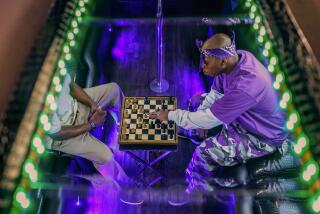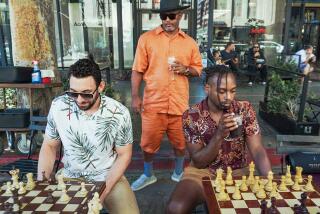Anthony Miles, First British Grandmaster, Dies at 46
- Share via
Nov. 16, 2001
Position No. 5664: Black to play and win. From the game Tkachiev -Chernin, Corsica 2001.
Solution to Position No. 5663: Black forces checkmate with 1 ... Qe2! 2 Rxe2 Rb1+.
ANTHONY MILES DIES
Anthony Miles, England’s top player in the 1970s and 1980s, died in his sleep Sunday at his home in Birmingham, England. He was 46.
Miles was a trendsetter. From the moment that he won the World Junior Championship in 1974, he embodied British chess. He was the first Englishman to receive the title of grandmaster, the first to defeat a world champion in the 20th century and the first to earn a comfortable living as a chess pro. He was also the first chess player subjected to the scrutiny of the British tabloids, which reported on the ups and downs of his chess career and his personal life.
At his peak, Miles was one of the world’s top 10 grandmasters, and almost certainly the busiest. For a decade, he participated in nearly every major tournament.
Miles did things his own way. He stunned Anatoly Karpov with the ridiculous “Birmingham Defense,” 1 e4 a6. He coped with back problems by lying on a massage table during games in a tournament in the Netherlands. He called Garry Kasparov “a 27-eyed monster who sees everything.” And he dealt with uncooperative British Chess Federation officials by claiming to represent, in succession, Andorra, Germany, the U.S. and Australia rather than England.
Local fans may remember Miles for his second-place finish in the 1980 Lone Pine tournament and his victory in the 1988 Software Toolworks tournament in Long Beach. He won $10,000 prizes in each event. During his brief stay in this country, he competed in the 1989 U.S. Championship in Long Beach, tying for fifth place.
Personally, I will remember Tony Miles for his droll sense of humor, a sharp contrast to his competitive spirit at the board. He beat me twice in a two-week span in 1976 and somehow made me feel good about it.
LOCAL NEWS
The 37th American Open will be held Nov. 22-25 at the Furama Hotel, 8601 Lincoln Blvd. in Los Angeles. Entrants in the eight-round main event may pay an additional $50 fee to become eligible for qualification to the U.S. Championship. The top dozen eligible scorers will earn invitations to the U.S. Championship in Seattle in January.
The holiday weekend includes a blitz (five-minute games) tournament at 8 p.m. Wednesday, a five-round scholastic event at 10 a.m. Saturday, a quick chess (10-minute games) tournament at 8:30 p.m. Saturday, a beginners tournament at 10 a.m. Sunday, free daily chess lectures and nonstop chess videos. For more details, call Jerry Hanken at (323) 257-9839 or Randy Hough at (626) 282-7412.
The Los Angeles Chess League, which features weekly matches between teams of four players, has completed a successful first season. Cacao Boys (Abdel Boutefnouchet, Danny Berman, Andre Felix, Ariel Mazzarelli and alternates Nathaniel Graham, Allan Karman, Lora Kao and Rob Eilbacher) won five matches and tied one to win the league’s first championship title. Santa Monica Bay Chess Club, which lost only to Cacao Boys, finished second at 5-1.
Other scores: USC, 4-2; Exposition Park No. 1, 3-3; LACC, 2-4; UCLA, 11/2-41/2; and Exposition Park No. 2, 0-6.
League organizer William Morriss plans to restart the league next spring if he can find two assistants. To volunteer, send a message to william_morriss@hotmail.com.
A record 45 players participated in the November Octos last Saturday at the Chess Center in Costa Mesa. Section winners were David Bassett, Arcie Pragale, Neil Bershad, Frank Berry, Thurlo Mishler and Selassie Fox. The next Octos are scheduled for Jan. 12.
TODAY’S GAMES
GM Karpov (U.S.S.R.) -GM Miles (England), European Team Championship, Skara 1980: 1 e4 a6 A shock to the world champion! 2 d4 b5 3 Nf3 Bb7 4 Bd3 Nf6 5 Qe2 e6 6 a4 c5! Counterattack! Black welcomes 7 axb5 axb5 and 7 e5 c4. 7 dxc5 Probably no stronger than the solid 7 c3. Bxc5 8 Nbd2 Karpov rejects 8 axb5 axb5 9 Rxa8 Bxa8 10 Bxb5 Nxe4 and 10 e5 Ng4. b4 9 e5 Nd5 10 Ne4 Be7 11 0-0 Nc6 12 Bd2 Against 12 Bg5, Miles intended 12 ... f6 13 exf6 gxf6 14 Bd2 Qc7, with thoughts of castling Queenside. Nc6 12 Bd2 Qc7 The pawn structure resembles a Sicilian Defense. Black has nearly equalized. 13 c4!? bxc3 14 Nxc3 Nxc3 15 Bxc3 Nb4 16 Bxb4 Black has no problems after 16 Be4 Bxe4 17 Qxe4 Nd5. Bxb4 17 Rac1 Qb6 18 Be4 0-0?! First 18 ... Be7 safeguards the King. 19 Ng5?! Right target, wrong approach. White should risk the unclear 19 Bxh7+! Kxh7 20 Ng5+ Kg6 21 Rc4. h6 20 Bh7+?! White can still back out with 20 Bxb7 Qxb7 21 Qe4, which should draw. Kh8 21 Bb1 Be7 Not fearing 22 Qd3 g6 23 Nxf7+? Rxf7 24 Qxg6, as 24 ... Rg7 25 Qxh6+ Kg8 26 g3 Bg5 turns the tables. 22 Ne4 Rac8 23 Qd3?? Losing. White should support his loose pawns with 23 Nc3. Rxc1 24 Rxc1 Qxb2 25 Re1 Or 25 Rc7 g6, when White is simply a pawn down. Qxe5 26 Qxd7 Bb4 27 Re3 Qd5 28 Qxd5 Bxd5 The extra pawn wins routinely. 29 Nc3 Rc8 30 Ne2 g5 31 h4 Kg7 32 hxg5 hxg5 33 Bd3 a5 34 Rg3 Kf6 35 Rg4 Bd6 36 Kf1 Be5 37 Ke1 Rh8 38 f4 gxf4 39 Nxf4 Bc6 40 Ne2 If 40 Bc2 Rh1+ 41 Kf2, then 41 ... Rc1 42 Bb3 Rb1 embarrasses the Bishop. Rh1+ 41 Kd2 Rh2 42 g3 Bf3 43 Rg8 Rg2 44 Ke1 Bxe2 45 Bxe2 Rxg3 46 Ra8 Bc7, White Resigns. Not a great game, but the first British victory over a world champion since Blackburne defeated Lasker in 1899.
GM Kudrin (U.S.A.) -GM Miles (U.S.A.), U.S. Championship, Long Beach 1989: 1 e4 Nc6 2 d4 e5 Sometimes called the Kevitz-Trajkovich Defense. 3 dxe5 The attacker’s choice. Strategists prefer 3 d5 Nce7 4 c4. Nxe5 4 Nf3 Bb4+ Bisguier often tries 4 ... Nxf3+ 5 Qxf3 Qf6, when 6 Qg3 favors White. 5 c3 Bd6 New at the time. 6 Nbd2 Nxf3+ 7 Nxf3 Ne7 8 e5 Bc5 9 b4 Bb6 10 Bf4 White wants to inhibit Black’s development by squelching ... d7-d6. 0-0 11 Bc4 Ng6 12 Bg3 d6! Anyway! 13 exd6 Re8+ 14 Be2 Qf6 15 0-0 Much too greedy is 15 Rc1 cxd6 16 Qxd6? Be6, as Black threatens 17 ... Bc4 and 17 ... Rad8. cxd6 16 Bb5 Rd8 17 Qd2 Bg4 18 Nd4 Rac8 Each player has active pieces and a weak pawn. Chances are even. 19 Rac1 Ne5 20 Rfe1 Rc7 21 Bf1 a6 22 Re4 Qg6 23 Rce1 f6 24 Kh1 Not 24 h3?? Bxh3 25 gxh3 Bxd4 26 cxd4 Nf3+. Rdc8 Dangerous, but it succeeds! 25 R4e3?! Passive. Critical is 25 f4! f5 26 R4e3 Nc4 27 Bxc4+ Rxc4 28 Re6. Black cannot stand 25 ... Nc4? 26 Bxc4+ Rxc4 27 f5! Bxf5 28 Nxf5 Qxf5 29 Rxc4 Rxc4 30 Qxd6, when his King is vulnerable. Bd7 26 a4 h5 27 f4 Too late! Ng4 28 Re7 h4! 29 Bxh4 Qh5 30 Bg3? A miscalculation in time pressure. After 30 Nf3! Qxh4 31 Nxh4 Nf2+ 32 Kg1, Black has to settle for repetition with 32
More to Read
Go beyond the scoreboard
Get the latest on L.A.'s teams in the daily Sports Report newsletter.
You may occasionally receive promotional content from the Los Angeles Times.










